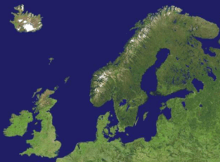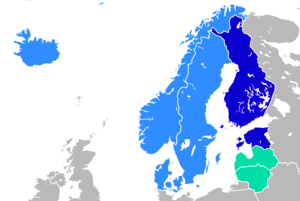Northern Europe


Northern Europe is the general term for the geographical region in Europe that is approximately north of the southern coast of the Baltic Sea. Nations usually included within this region are Denmark, Estonia, the Faroe Islands, Finland, Iceland, Latvia, Lithuania, Norway and Sweden, and less often the United Kingdom, the Republic of Ireland,[1] northern Germany, northern Belarus and northwest Russia.
Narrower definitions may be based on other geographical factors such as climate and ecology. A broader definition would include the area north of the Alps. Countries which are central-western (such as Belgium), central (such as Austria) or central-eastern (such as Poland) are not usually considered part of either Northern or Southern Europe.
Historically, when Europe was dominated by the Roman Empire, everything not near the Mediterranean region was termed Northern Europe, including southern Germany, all of the Low Countries, and Austria. This meaning is still used today in some contexts, for example, discussions of the Northern Renaissance.
Geography
.png)
Blue: Northern Europe
Green: Western Europe
Red: Central and Eastern Europe
Yellow: Southern Europe
Grey: Territories not considered part of Europe
Northern Europe consists roughly of the British Isles, Fennoscandia, the peninsula of Jutland, the Baltic plain that lies to the east and the many islands that lie offshore from mainland Northern Europe, Greenland, and the main European continent.
The area is defined by the volcanic islands of the far northwest, notably Iceland and Jan Mayen, the mountainous western seaboard, extending from the mountainous sections of Great Britain and Ireland to the Scandinavian mountains peaking in Norway, the central north mountains and hills of Sweden (which are the foothills of the Scandinavian mountains) and the large eastern plain, which contains, Lithuania, Latvia, Estonia and Finland.
The region has a south west extreme of around 50 degrees north and a northern extreme of 81 degrees north. The entire region's climate is mildly affected by the Gulf Stream. From the west climates vary from maritime and maritime subarctic climates. In the north and central climates are generally subarctic or Arctic and to the east climates are mostly subarctic and temperate/continental.
Just as both climate and relief are variable across the region, so too is vegetation also extremely variable, with sparse tundra in the north and high mountains, boreal forest on the north-eastern and central regions temperate coniferous forests (formerly of which a majority was in the Scottish Highlands and south west Norway) and temperate broadleaf forests growing in the south, west and temperate east.
With the exception of the United Kingdom and Ireland, which are warmed by the Gulf Stream and south-westerly winds from the Rocky Mountains,[2] Northern European countries are known for harsh winters with temperatures reaching as low as minus 50 degrees Celsius in some parts.[3]
Demographics
Countries commonly included in their entirety within the region, by population count:
















The parts of Germany, Russia and Belarus that are often included have no exact borders.
Countries in Northern Europe have large, developed economies and some of the highest standards of living in the world. They often score highly on surveys measuring quality of life, such as the Human Development Index. Aside from the United Kingdom, they generally have a small population relative to their size, most of which live in cities. Most peoples living in Northern Europe are Protestant Christians, although many are non-practicing. There is also a growing number of irreligious peoples and Muslims, the latter of which is due to immigration. The United Kingdom is an outlier in this regard, as heavy immigration from its former colony, the British Raj, particularly modern-day India, has also added Hindus, a religion found in minuscule numbers in all other Northern European countries. The quality of education in Northern Europe is rated highly in international rankings, with Estonia and Finland topping the list among the OECD countries in Europe.
See also
References
- ↑ Definition of regions, United Nations Department of Economic and Social Affairs
- ↑ Connor, Steve (10 February 2003). "Forget about the Gulf Stream: Britain is really kept warm in winter by the Rocky Mountains". The Independent. London. Retrieved 9 February 2018.
- ↑ "Norway Climate". Visit Norway. 2011. Retrieved 31 October 2011.
External links
